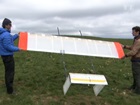| Image: The TwingKite is based on Empa’s Tensairity technology. A kite, a reel and a console. These are the components of a pioneering new method for generating energy. The research and development project being carried out by Empa, the University of Applied Sciences Northwest Switzerland, the Federal Institute of Technology in Zurich (ETH Zurich) and the Federal Institute of Technology in Lausanne (EPFL), combines the basic concept of a kite with innovative technology. The aim: to make electricity from the wind. That in itself is nothing new; electricity is already being produced by wind turbines, yet these only reach heights of around 100 metres. With the “Twing” from Empa, stronger and more regular wind currents at up to three hundred metres are “tapped”. A key component of this is the Tensairity structure, which is being studied and developed by Empa’s “Center for Synergetic Structures”. Dual success
“Venture Kick” is convinced that kite power is not just an idea, but can also be economically viable. The programme, which supports start-ups, is investing CHF 10,000 in this innovative project. Projects can receive up to CHF 130,000 during the three-stage “Venture Kick” process; the Twingtec team has now cleared the first hurdle. In a further step, the idea is being further developed and subsequently re-evaluated with active support from experienced entrepreneurs. This innovative approach has also met with widespread interest in the media. For example, “ServusTV” and the Swiss science programme “Einstein” presented detailed reports on the kite’s first successful test flight. From movement comes energy
The principle is simple: the high-tech kite is fastened to lines attached to the reel in the ground station. The kite rises up to high altitudes with strong winds, which creates tension on the line setting the reel in motion. This movement is then converted into electrical energy by means of electromagnetic induction. Once the kite reaches its maximum height, the reel pulls it back down so it can rise again. Initial tests in the Bernese Jura region were successful. The team’s objective now is to make the “Twing” even more efficient. The structure is based on the ultra-lightweight Tensairity girder – a beam made of struts, tension elements, a membrane and air, with an enormous load-bearing capacity. This kite is being designed to ascend to altitudes of up to three hundred metres, withstand the very strong wind forces and may soon supply our houses with clean electricity from the windy heights. | 
